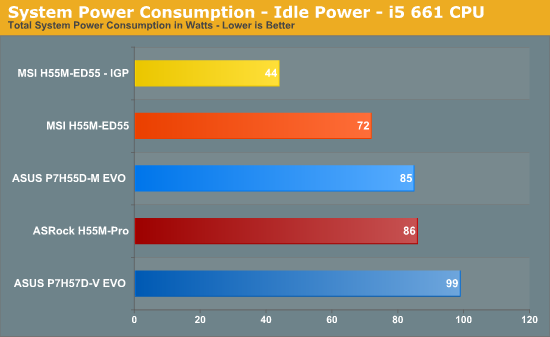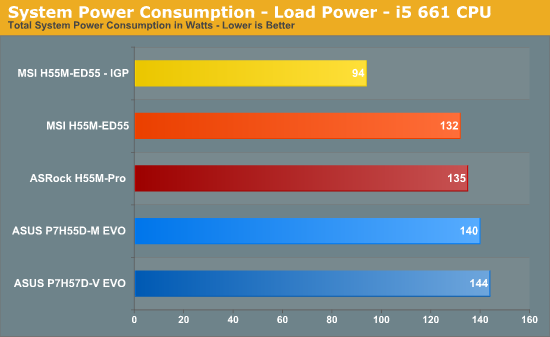Choosing the Best H55/H57 Motherboard - Part 1
by Rajinder Gill on January 31, 2010 11:30 PM EST- Posted in
- Motherboards
Testbed Setup and Power
| Testbed Setup - Overclocking / Benchmark | |
| Processor | Intel Core i5 661 ES CPU - 3.33GHz - 2 Cores 4 Threads, 4MB Cache |
| CPU Voltage | Various |
| Cooling | Intel air cooler Heatkiller 3.0 waterblock PA120.2 radiator and DDC ultra pump (with Petra top) 1/2 ID tubing for watercooling |
| Power Supply | Corsair HX950 |
| Memory | Corsair Dominator CMD8GX3M4A1600C8 1600MHz 8GB kit G.Skill Perfect Storm 8-8-8-24 2200MHz 4GB kit Corsair Dominator GT 8-8-8-24 2200MHz 4GB kit (X2 for 8GB) |
| Memory Settings | Various |
| Video Cards | MSI 275 Lightning (stock clocks) |
| Video Drivers | nVidia 195.62 WHQL |
| Hard Drive | Western Digital 7200RPM 1TB SATA 3/Gbps 32MB Buffer OCZ Vertex 120GB SSD |
| Optical Drives | Plextor PX-B900A Toshiba SD-H802A |
| Case | Open Test Bed - Dimastech Benching Station Lian-Li V2110 |
| Operating System | Windows 7 64 bit |
| . | |
We utilized memory kits from Corsair and G.Skill to verify memory compatibility on our test boards. Our OS and primary applications are loaded on the OCZ Vertex 120GB SSD drive and our games operate off the WD Caviar Black 1TB drive. We did a clean install of the OS and applications for each motherboard.
We used Intel's stock cooler for the stock comparison testing, while water-cooling via the superlative Heat Killer 3.0 water block was utilized for overclocking. For graphics duty, we used MSI's GTX 275 Lighting GPU to provide performance comparisons between boards during gaming benchmarks.
For our test results we set up each board as closely as possible in regards to memory timings. Otherwise all other settings are left on auto. The P55 utilized 8GB of DDR3 (apart from DFI's MI-T36 which is limited to 4GB), while the X58 platform contained 6GB. The P55 and X58 DDR3 timings were set to 7-7-7-20 1T at DDR3-1600 for the i7-920 and i7-870 processors at both stock and overclocked CPU settings.
We used DDR3-1333 6-6-6-18 1T timings for the i5-750 stock setup for all system benchmarks (non-gaming tests) as DDR3-1600 is not natively supported at a stock BCLK setting of 133.
For our Clarkdale i5 661 CPU, we used 7-7-7-20 1N timings at DDR3-1333MHz with 8GB of memory. We would have preferred to use CAS 6 timings to match our Lynnfield setup, but it seems 8GB of memory at CAS 6 on Clarkdale is not possible right now. The 4GHz gaming results used 8GB of memory at DDR3-1200 with CAS 6-6-6-18 1N timings to allow a BCLK of 200MHz with the QPI ratio in sync with CPU frequency.
There's little to separate these boards when you run them at a fixed frequency, showing nothing more than a 1-2% swing in most instances, which goes completely unnoticed in real world usage.
Power consumption
Our power consumption testing utilizes the same batch of components under similar circumstances in a bid to monitor variances between idle and CPU load conditions using an AC wall meter for power consumption measurements. We install the vendor supplied power saving utilitites on each board and enable power saving modes that don't involve any kind of underclocking or CPU core frequency modulation in order to run an apples to apples comparison.
Assuming a maximum 150w load in the worst case scenario, actual motherboard power consumption is around 15%~17% lower than the shown figures if you factor out switching losses at the PSU.


MSI continues in its dominance of idle/light load power saving performance by using buck controllers that support low switching speeds and allow phases to be turned off in light load conditions.
A graphics card like nVidia's 275 will add around 28w of idle power consumption to a Clarkdale system. It is unfortunate that Intel (and board vendors) do not offer drivers/GPU power management that allow a discrete GPU to be powered on/off on demand - the power savings would be rather attractive.
Note that most of the CPU VCC power saving features on these boards need to be turned off when overclocking to ensure system stability and to prevent PWM burnouts under modulating loads at higher levels of current draw. With power saving features switched off, you get a 5~10W increase in the idle power consumption at the same operating frequency, while load power consumption remains roughly the same due to current loading.










56 Comments
View All Comments
crochat - Wednesday, February 3, 2010 - link
In my opinion testing H5X boards should focus on IGP. Isn't that the aim of the chipset to use CPUs with IGP? Instead of the gaming benchmarks I'd be much more interested in multimedia and peripheral (firewire, esata, usb, networking) performance.Regards
thorgal73 - Tuesday, February 2, 2010 - link
Just to let you know, Massman found the solution to the IGP overclocking problem :http://www.madshrimps.be/?action=getarticle&ar...">http://www.madshrimps.be/?action=getarticle&ar...
Cheers!
Rajinder Gill - Tuesday, February 2, 2010 - link
Thanks for the link.That actually makes a lot of sense and explains the extra IGP voltage you have to pump - even though BIOS shows a fixed IGP freqeuncy.
Probably a good idea just to make it into an Excel calc so people can use it easily.
http://www.mediafire.com/file/2go0yotyz5z/quick">http://www.mediafire.com/file/2go0yotyz5z/quick igp calc.xlsx
later
Raja
Rajinder Gill - Tuesday, February 2, 2010 - link
This one's a bit better, easy to work out the required BCLK for and equivalent IGP frequency at various IGP multiplier ratios.http://www.mediafire.com/file/nhfnnedgzwb/quick">http://www.mediafire.com/file/nhfnnedgzwb/quick igp calc.xlsx
yuhong - Monday, February 1, 2010 - link
"If you're going to use the IGP, you don't really need the extra PCI-E lanes, which essentially means that you're paying for the option to run RAID on the H57 PCH. "Well, USB 3.0 and SATA 6GBps takes 4 PCIe lanes.
Rajinder Gill - Monday, February 1, 2010 - link
You're looking at $200 boards that offer both SATA 6G and USB 3.0 in tandem unfortunately. USB 3.0 can be had under $130, with enough PCI/e left over for upgrading IMO.Nataku - Monday, February 1, 2010 - link
Just wondering (may be I'm just being dumb)Do you know if any or all of the h55 boards support dual screen?
I've been wanting to build a HTPC and dual screen it with my TV and a touch screen, but wasn't sure if the video out can actually work in dual screen mode.(ran into one that only ran in clone long ago =.=)
Also, this is off topic but, will you guys be making some reviews on touch screen monitors? HP and Dell are selling 20"+ touchscreens at around 300CAD but Firebox and Elo are selling 15" at 4~500CAD. Just curious how that part of the industry are coming along (20" too big imo to be beside a TV...)
Rajinder Gill - Monday, February 1, 2010 - link
Hi,Yes, dual display options are offered as part of Intel's drivers for the IGP. So you should be able to setup both options. I've tried with DVI and HDMI outputs simultaneously and it recognises both fine and allows you to set them up.
Jarred's the guy for monitors and such, so I'll pass the info over to him.
Hope this helps..
Raja
Nataku - Thursday, February 4, 2010 - link
Thanks :)Rick83 - Monday, February 1, 2010 - link
I am currently looking to upgrade my server and the savings from replacing the old nv 6200 with on-chip graphics are attractive.Now, normally this would be a done decision, but I am planning on running quite a few drives in that box, 14 to be precise. Currently I have one RAID 5, one RAID 1, one root disk and one optical drive, I will add another RAID 5 and another RAID 1 as part of the upgrade. All except 5 drives are attached via SATA. I already have an IDE-controller installed via PCI, but I'd like to avoid installing an extra SATA controller, as it seems much cheaper to just go for a board with 10x SATA on board.
But due to my use of full-disk encryption, I'd really like to be able to access AES-NI, so it will have to be a clarksdale i5. There are P55 boards with 10 SATA ports, and X58 boards too, but I'd really like to go with the on-chip graphics, both to save what little pci-e I have on these boards, as well as to save the space and energy.
Does anyone reasonably expect Asus or Gigabyte or MSI (as those are the usual suspects for 10x SATA) to release such a board based on H5x? If not, I'd best grab an old Gigabyte P55 UD5 soon...